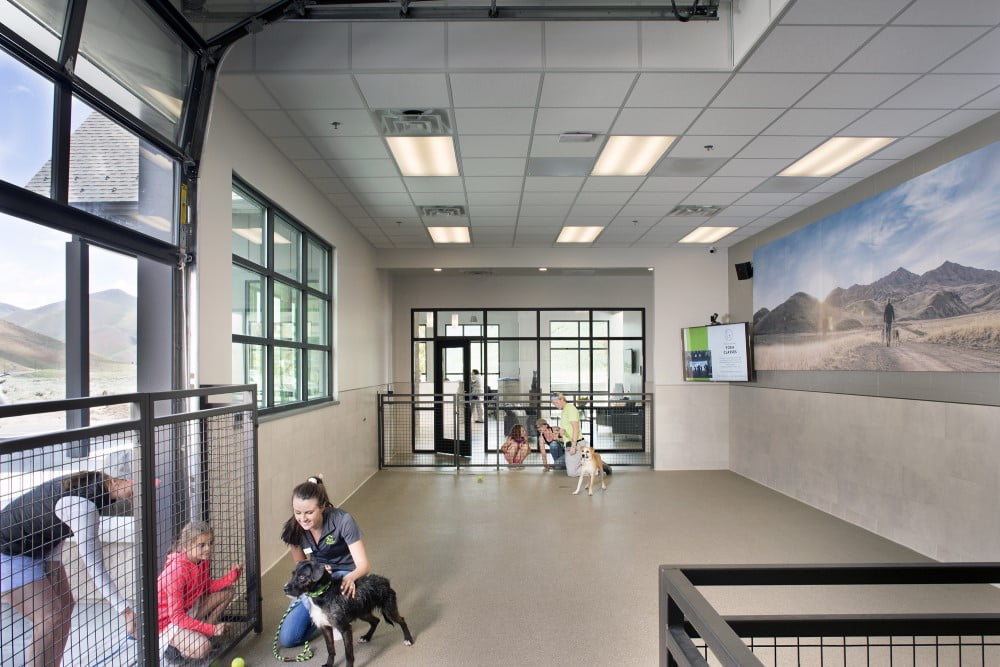Unwanted noise equals stress. This is true for humans and animals. Whether it’s dogs barking, cage doors clanging, lights humming, or overhead paging systems paging, noise can add to stress in situations that are commonly already fraught in both veterinary hospitals and animal shelters.
How Dogs and Cats Hear
There is some variation in the exact start and end points of the hearing ranges that researchers have measured for humans, dogs, and cats, but it’s reasonable to say that dogs hear at twice the range humans do and cats hear triple the range of humans. Both dogs and cats can hear and distinguish many high frequency sounds that are not audible to us. Just because you don’t hear the hum coming from your HVAC, doesn’t mean the animals in housing situated just below those rooftop units can’t.
As well as having a larger frequency range, dogs and cats are also more sensitive to sound decibels, i.e., loudness and softness. This means that everyday sounds like vacuum cleaners and the wheels on carts can sound louder to dogs and cats than they do to us.
Their acute hearing means that creating environments that are less audibly overstimulating or anxiety producing for animals can be a challenge. There are several methods that can help us to create quieter, calmer animal care environments.
Prevention
An ounce of prevention really can go a long way in helping reduce noise-induced stress. One way is to help prevent dogs from barking. Larger, square kennels that allow dogs to move more naturally, that are view blocked from other dogs, and that include enrichments, natural light, and proper air changes, can reduce the stressors that incite dogs to bark.

Dog Boarding at Prescott Animal Hospital with larger, square kennels, view blocking, natural light, and enrichments.
Other ways we can prevent noise are by specifying quiet latches on cages, and casters on chairs and rolling carts. Paging systems that rely on colored lights instead of sounds are another option.
Absorption
Absorption is the process of using materials that literally absorb sound waves. Materials are given Noise Reduction Coefficient ratings, to indicate how much sound they absorb. A typical ceiling tile has an NRC of .65, meaning that it absorbs 65 percent of the reverberant sound that hits it within the tested frequency range.
Absorption is a great technique, but it has limits. Many of the better sound absorbing materials are not practical for the use and abuse they would take in an animal care setting. There are also limits on how much sound within a given space can be absorbed based on the size of the space and the amount of these materials that can be incorporated. To achieve the best noise absorption given the limitations, follow these suggestions: 1) use the highest NRC possible for ceiling materials, 2) place sound panels on the wall from the ceiling down to a height of 7′ to increase noise absorbing surfaces, 3) choose the highest NRC possible on the sound panels and also the thickest panels (2″ panels perform better than 1″ panels), and 4) choose sound-absorbing materials that are antimicrobial, you may need to consult with experts to find the best products.

At Mountain Humane acoustic tiles on the ceiling and a custom acoustic panel with a view of the mountains help keep the sounds of dogs at play away from other areas of the shelter.
Isolation
This is the idea of containing sound within a specific area. A Sound Transmission Class is a rating of how much noise passes through something. Dogs bark at a range of 100 decibels or higher. This means that in order to completely isolate that barking, you would need to create wall assemblies with an STC of 100 or better. A typical wall can isolate between 35-55 decibels. Fortunately, the remaining sound that escapes can usually be masked by normal background sounds. But, noise is sneaky. It will find a way to escape and make itself heard, so if you’ve trapped it by the walls, it will try to sneak out the floor or ceiling. There are a few other strategies that are important to isolation, including: 1) seal all penetrations in sound insulating walls, 2) gasket all doors and use sound insulating doors and windows within sound walls, and 3) use buffer zones such as hallways around dogs.
Dissipation
Sounds, without surfaces to bounce off of, will die off on their own, which is obvious if you’ve ever tried to get the attention of someone on the far end of a football field. So, placing spaces within the hospital that should be quiet on the opposite side of the building from noisier spaces, in conjunction with the other methods discussed here, will help to provide the quieter environment you’re looking for.
Good HVAC design
Your mechanical engineer should be able to help you by specifying equipment that does not add mechanical system noises to the interior of your hospital.
Masking
As a final measure, you can add some white noise, or quiet music to your animal housing spaces to help mask unpleasant sounds that might seep in.
This was just a brief outline of the sound issues and mitigation options that can be found in animal care environments. For more information, you can check out our book on veterinary hospital design available from AAHA Press or drop a comment below.


